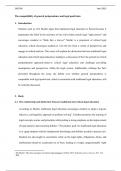2455766 April 2023
The compatibility of general jurisprudence and legal positivism
1. Introduction
Scholars such as J.M. Modiri argue that traditional legal education is flawed because it
perpetuates the belief in the existence of one self-evident, purely legal "right answer" and
encourages students to "think like a lawyer." Modiri is a proponent of critical legal
education, which encourages students to view the law from a variety of perspectives and
engage in critical analysis. This essay will explain the distinction between traditional legal
education and critical legal education, leading to a discussion of how the general or critical
jurisprudential approach relates to critical legal education and challenge prevailing
assumptions and perspectives within the legal system. Additionally, utilising the facts
presented throughout the essay, the debate over whether general jurisprudence is
compatible with legal positivism, which is associated with traditional legal education, will
be critically discussed.
2. Body
2.1. The relationship and distinction between traditional and critical legal education
According to Modiri, traditional legal education encourages students to adopt a logical,
objective, and legalistic approach to problem-solving1. It further promotes the learning of
legal concepts, norms, and principles while putting a strong emphasis on the improvement
of legal analysis and reasoning abilities.2 The primary goal of a traditional legal education
is to equip students with the fundamental knowledge and abilities needed to practice law.
Students are also taught to concentrate solely on the legal rights, obligations, duties, and
entitlements related to a particular set of facts, leading to a single, unquestionable ‘right
1
JM Modiri ‘The time and space of critical legal pedagogy’ (2016) 27(3) Stellenbosch Law Review 507, 512.
2
Ibid.
, 2455766 April 2023
answer’.3 This approach, however, does not fully develop the complete range of abilities
students will need as lawyers and can lead to a narrow and limited knowledge of the law.
It also fails to take into consideration the social and political settings in which law
functions.4
According to Modiri, one of the main objectives of critical legal education is to challenge
the traditional legal education's concentration on judicial norms, doctrines, and principles.5
Unlike the traditional approach, a critical legal education recognises that law is not a self-
contained system of rules but is shaped by power relations, social norms, and social
ideologies. Critical legal education aims to promote a more holistic and contextual
understanding of the law, one that takes into account the social and political context in
which law is made, applied, and enforced. It challenges the predominate beliefs and
viewpoints inside the legal system and encourages students to think critically and
creatively about issues.6 In order to achieve social justice and equality, it encourages
students to critically analyse, assess, and criticise the ways in which the law upholds and
reinforces existing power systems.7
Overall, a traditional legal education and a critical legal education in jurisprudence are two
distinct approaches to legal education. While both approaches seek to provide students
with a solid understanding of the law and legal practice, the primary distinction between
the two is the emphasis they place on technical skills versus critical analysis and social
3
Ibid 512.
4
Ibid 513.
5
Ibid 512.
6
Ibid 509.
7
Ibid 510.




